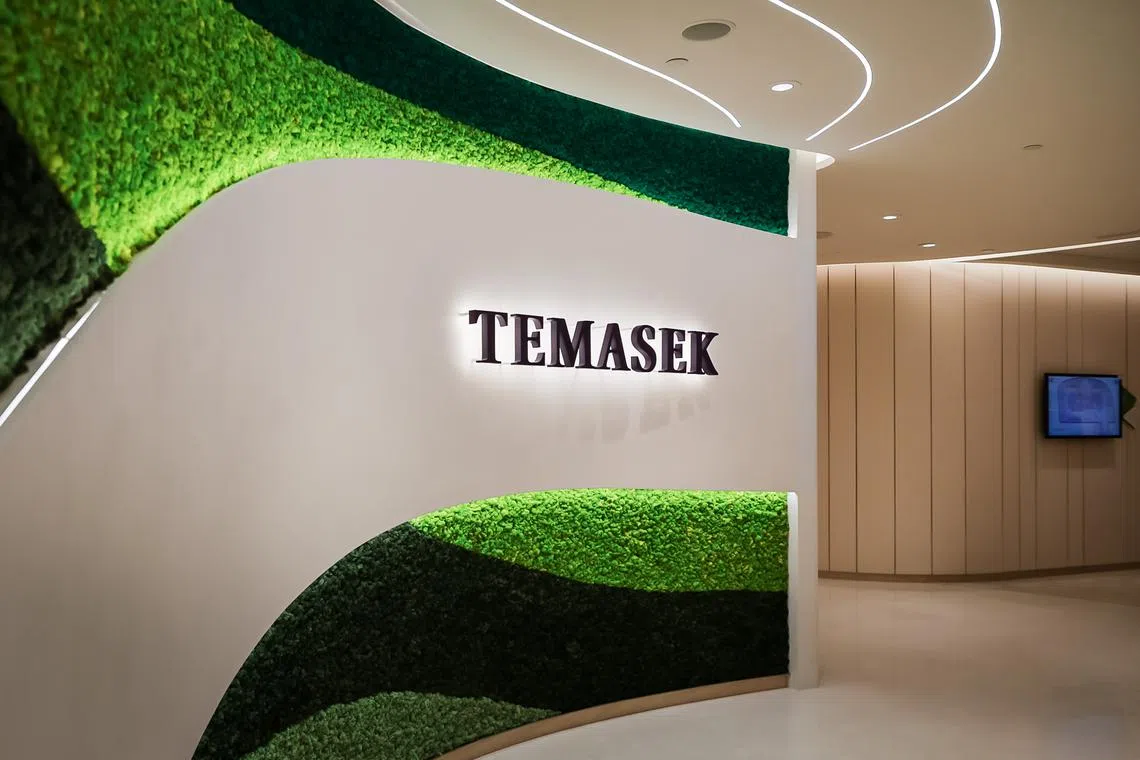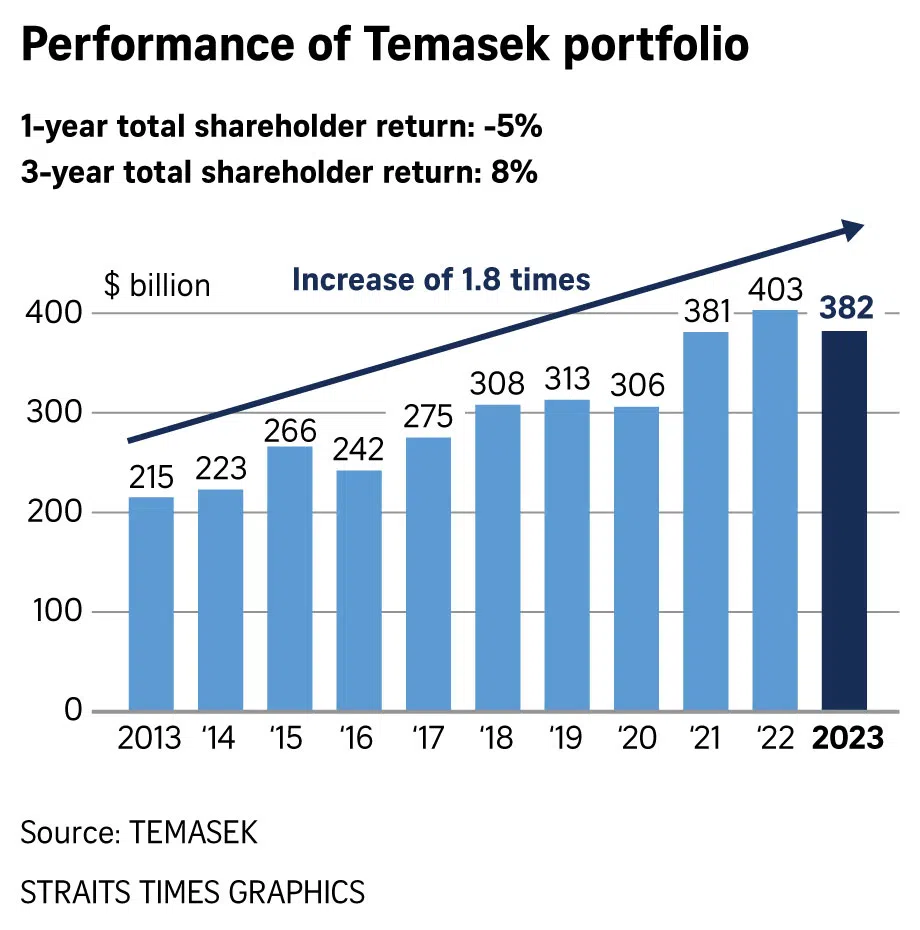Temasek makes $7 billion loss as one-year shareholder return turns negative
Sign up now: Get ST's newsletters delivered to your inbox

Temasek's net portfolio dropped to $382 billion from a record $403 billion a year ago.
ST PHOTO: GAVIN FOO
Follow topic:
SINGAPORE – High inflation, geopolitical risks and slowing economic growth
Including write-downs and unrealised losses in a certain category of investments, Temasek posted a $7.3 billion net loss for the 2023 financial year that ended on March 31, its first time in the red since a $6.7 billion loss in 2016 and a reversal from an $11 billion net profit a year ago.
Chief financial officer Png Chin Yee said the loss is a reporting requirement under the International Financial Reporting Standards adopted in April 2018 and will not affect Temasek’s Net Investment Returns Contribution (NIRC) to Singapore’s annual Budget.
Without the unrealised losses, Temasek would have posted a $14.7 billion net profit, she said.
Among the world’s top state investors, Temasek said in its annual review on Tuesday that the value of its net portfolio dropped to $382 billion in financial year 2023, from a record $403 billion the previous year. The portfolio was valued at $381 billion as at the end of March 2021.
Its one-year total shareholder return (TSR) fell to minus 5.07 per cent from plus 5.81 per cent a year earlier, as high interest rates eroded the value of global direct investments, particularly those in technology, healthcare and payments, it said.
In November, Temasek said it would write down its US$275 million (S$369 million) investment in failed cryptocurrency exchange FTX
Temasek’s investments benefit Singaporeans through the NIRC framework. Under this, the Government can spend up to half of the long-term expected investment returns generated by Temasek, sovereign wealth fund GIC and the Monetary Authority of Singapore (MAS) – the three entities tasked to invest Singapore’s reserves.
Temasek announced its loss a week after MAS posted a record $30.8 billion loss
Explaining why its overall portfolio has shrunk and one-year TSR turned negative, Temasek said: “In the past year, we have encountered persistent inflation despite multiple rate hikes by central banks.”
In addition, intensifying geopolitical tensions on several fronts,
“The confluence of these events, not seen in decades, has raised the cost of capital and weighed on capital flows,” said Temasek.
The state investor has seen much better years in the past. It delivered a one-year return of 24.53 per cent in financial year 2021,
Still, Temasek’s overall portfolio performance sustained its recovery from the lows during Covid-19. Its three-year TSR came in at 8 per cent, while the TSR since inception in 1974 remained robust at 14 per cent.
Ten-year returns stood at 6 per cent versus 7 per cent in financial year 2022, while 20-year returns were at 9 per cent against 8 per cent in the previous year.
Temasek also slowed its investment pace amid global uncertainties. It invested $31 billion and divested $27 billion in the 2023 financial year, resulting in a net investment of $4 billion. In financial year 2022, Temasek made a decade-high $61 billion worth of investments and $37 billion of divestments.
It kept its portfolio anchored in Asia, which accounted for 63 per cent of its underlying assets.
Singapore was Temasek’s top investment location for the second year in a row as it raised allocation to 28 per cent of its portfolio, up from 27 per cent a year ago. This was followed by China, with 22 per cent, and the Americas, with 21 per cent.
Temasek said its Singapore portfolio companies remain resilient despite drawdowns in the global markets and the challenging macro environment.
“We continued to invest into opportunities that are aligned with long-term structural trends, and engaged our large Singapore portfolio companies to seek out opportunities of the future,” it added.
Mr Rohit Sipahimalani, Temasek’s chief investment officer, said that Singapore in the near term faces slowing global growth and elevated inflation against a challenging economic backdrop.
“While China’s reopening could provide some support, the Singapore economy is geared more towards domestic demand in developed markets, which could experience a recession,” he said.
He added: “Adding to the complexity, geopolitical tensions have risen, although Singapore could stand to benefit from diversification of supply chains around the region, both in the near and medium term.”
Temasek chairman Lim Boon Heng noted that 2022 was the most challenging year for markets over the past decade, with high interest rates, lower growth and a highly polarised geopolitical environment.
As listed assets fell victim to the global market downturn, Temasek opted to further raise its exposure to unlisted assets to 53 per cent, up from 52 per cent in financial year 2022 and 45 per cent in financial year 2021.
It said its unlisted portfolio is well diversified across geographies and sectors, and has grown steadily over the years, due to its investments in attractive opportunities in private markets and the increase in the value of those unlisted assets.
Given Temasek’s bottom-up investment approach, where it buys assets that are likely to give steady returns in the longer run, its exposure to unlisted assets has risen to 53 per cent, up from 27 per cent in 2013.
Over the past decade, the unlisted portfolio has also generated returns of more than 10 per cent a year on an internal rate-of-return basis, delivering higher returns than its listed portfolio.
Unlisted companies, for instance SP Group and PSA, have consistently supplied a steady stream of dividend income for Temasek.

Mr Dilhan Pillay, Temasek’s executive director and chief executive, pointed out key challenges in the future.
“For the first time in decades, sticky inflation and tighter monetary conditions are manifesting themselves in significantly higher interest rates. The investment climate has become much more complex than what we have encountered since the global financial crisis.”
He added that several factors portend lower global growth and lower real returns, and are challenging issues that investors will have to grapple with. These include rising geopolitical tensions, the risk of decoupling amid a rethinking of globalisation, the emergence of potentially restrictive, nationalistic and protectionist policies amid the proliferation of foreign investment regimes, and the costs associated with energy security and energy transition.


